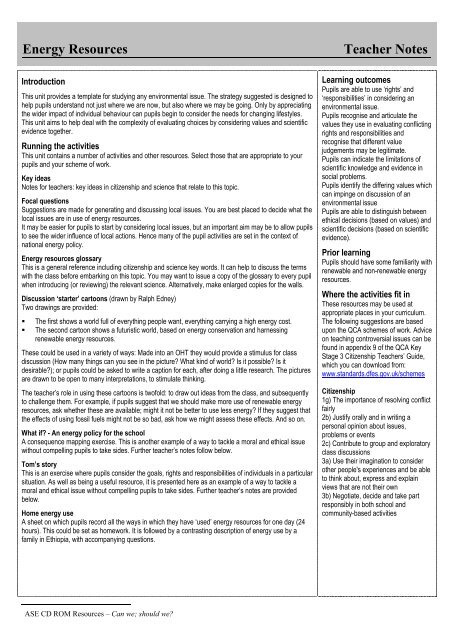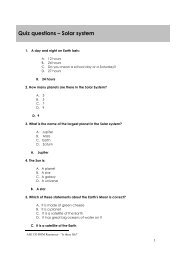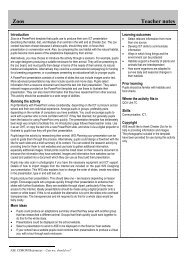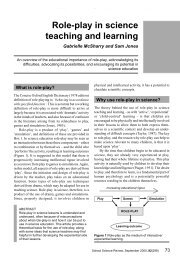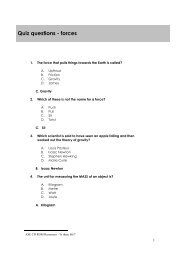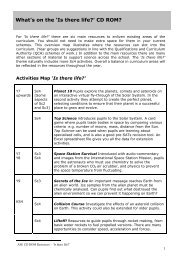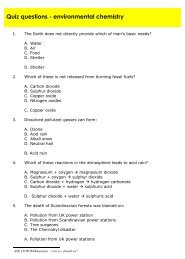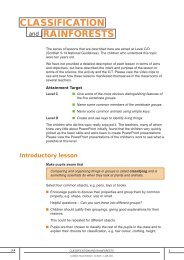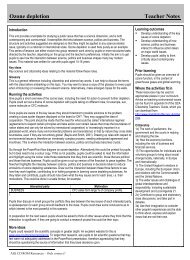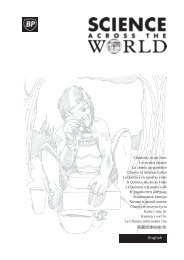Energy Resources Teacher Notes - National STEM Centre
Energy Resources Teacher Notes - National STEM Centre
Energy Resources Teacher Notes - National STEM Centre
You also want an ePaper? Increase the reach of your titles
YUMPU automatically turns print PDFs into web optimized ePapers that Google loves.
<strong>Energy</strong> <strong>Resources</strong><br />
Introduction<br />
This unit provides a template for studying any environmental issue. The strategy suggested is designed to<br />
help pupils understand not just where we are now, but also where we may be going. Only by appreciating<br />
the wider impact of individual behaviour can pupils begin to consider the needs for changing lifestyles.<br />
This unit aims to help deal with the complexity of evaluating choices by considering values and scientific<br />
evidence together.<br />
Running the activities<br />
This unit contains a number of activities and other resources. Select those that are appropriate to your<br />
pupils and your scheme of work.<br />
Key ideas<br />
<strong>Notes</strong> for teachers: key ideas in citizenship and science that relate to this topic.<br />
Focal questions<br />
Suggestions are made for generating and discussing local issues. You are best placed to decide what the<br />
local issues are in use of energy resources.<br />
It may be easier for pupils to start by considering local issues, but an important aim may be to allow pupils<br />
to see the wider influence of local actions. Hence many of the pupil activities are set in the context of<br />
national energy policy.<br />
<strong>Energy</strong> resources glossary<br />
This is a general reference including citizenship and science key words. It can help to discuss the terms<br />
with the class before embarking on this topic. You may want to issue a copy of the glossary to every pupil<br />
when introducing (or reviewing) the relevant science. Alternatively, make enlarged copies for the walls.<br />
Discussion ‘starter’ cartoons (drawn by Ralph Edney)<br />
Two drawings are provided:<br />
The first shows a world full of everything people want, everything carrying a high energy cost.<br />
The second cartoon shows a futuristic world, based on energy conservation and harnessing<br />
renewable energy resources.<br />
These could be used in a variety of ways: Made into an OHT they would provide a stimulus for class<br />
discussion (How many things can you see in the picture? What kind of world? Is it possible? Is it<br />
desirable?); or pupils could be asked to write a caption for each, after doing a little research. The pictures<br />
are drawn to be open to many interpretations, to stimulate thinking.<br />
The teacher’s role in using these cartoons is twofold: to draw out ideas from the class, and subsequently<br />
to challenge them. For example, if pupils suggest that we should make more use of renewable energy<br />
resources, ask whether these are available; might it not be better to use less energy? If they suggest that<br />
the effects of using fossil fuels might not be so bad, ask how we might assess these effects. And so on.<br />
What if? - An energy policy for the school<br />
A consequence mapping exercise. This is another example of a way to tackle a moral and ethical issue<br />
without compelling pupils to take sides. Further teacher’s notes follow below.<br />
Tom’s story<br />
This is an exercise where pupils consider the goals, rights and responsibilities of individuals in a particular<br />
situation. As well as being a useful resource, it is presented here as an example of a way to tackle a<br />
moral and ethical issue without compelling pupils to take sides. Further teacher’s notes are provided<br />
below.<br />
Home energy use<br />
A sheet on which pupils record all the ways in which they have ‘used’ energy resources for one day (24<br />
hours). This could be set as homework. It is followed by a contrasting description of energy use by a<br />
family in Ethiopia, with accompanying questions.<br />
<strong>Teacher</strong> <strong>Notes</strong><br />
Learning outcomes<br />
Pupils are able to use ‘rights’ and<br />
‘responsibilities’ in considering an<br />
environmental issue.<br />
Pupils recognise and articulate the<br />
values they use in evaluating conflicting<br />
rights and responsibilities and<br />
recognise that different value<br />
judgements may be legitimate.<br />
Pupils can indicate the limitations of<br />
scientific knowledge and evidence in<br />
social problems.<br />
Pupils identify the differing values which<br />
can impinge on discussion of an<br />
environmental issue<br />
Pupils are able to distinguish between<br />
ethical decisions (based on values) and<br />
scientific decisions (based on scientific<br />
evidence).<br />
Prior learning<br />
Pupils should have some familiarity with<br />
renewable and non-renewable energy<br />
resources.<br />
Where the activities fit in<br />
These resources may be used at<br />
appropriate places in your curriculum.<br />
The following suggestions are based<br />
upon the QCA schemes of work. Advice<br />
on teaching controversial issues can be<br />
found in appendix 9 of the QCA Key<br />
Stage 3 Citizenship <strong>Teacher</strong>s’ Guide,<br />
which you can download from:<br />
www.standards.dfes.gov.uk/schemes<br />
Citizenship<br />
1g) The importance of resolving conflict<br />
fairly<br />
2b) Justify orally and in writing a<br />
personal opinion about issues,<br />
problems or events<br />
2c) Contribute to group and exploratory<br />
class discussions<br />
3a) Use their imagination to consider<br />
other people's experiences and be able<br />
to think about, express and explain<br />
views that are not their own<br />
3b) Negotiate, decide and take part<br />
responsibly in both school and<br />
community-based activities<br />
ASE CD ROM <strong>Resources</strong> – Can we; should we?
<strong>Energy</strong> <strong>Resources</strong><br />
<strong>Teacher</strong> <strong>Notes</strong><br />
Give us Sunshine (by Andy Merriman)<br />
A compelling drama for pupils to perform, wherein our heroine Jade is suddenly faced with a dilemma and<br />
has to think hard to work out what to do. There are lots of ‘energy threads’ for pupils to identify. The<br />
drama is intended to prompt a lively discussion about conflicting values.<br />
You could use this as the basis for an assembly, perhaps during Science Week.<br />
Users should feel free to adapt this script in any way they see fit, for example to bring in local issues, local<br />
humour, etc.<br />
Give us Sunshine – scene 1<br />
A sound recording of the introductory part of the drama, recorded on location at a school. For use as an<br />
introduction to the play script.<br />
Living with risk<br />
This is an extension activity on the probability and psychology of risk, which can be used as an<br />
introduction to any discussion informed by an assessment of risks. For example, it can be a pre-cursor to<br />
discussing how we weigh up the risks and benefits around a controversial issue.<br />
Science<br />
Various aspects of the science<br />
curriculum may be covered, depending<br />
on the route chosen through the<br />
activities:<br />
7I) <strong>Energy</strong> resources: renewable vs.<br />
non-renewable resources<br />
8I) Heating and cooling<br />
9G) Environmental Chemistry<br />
9I) <strong>Energy</strong> and Electricity<br />
Safety<br />
Not applicable.<br />
The intentions of the activity are to:<br />
Give pupils an introduction to the concept of risk;<br />
Allow pupils to recognise that they may perceive lower risk in a voluntary activity than in an<br />
involuntary activity;<br />
Allow pupils to recognise that risk assessment is not straightforward; that no activity is risk free; that<br />
we do not necessarily make rational choices based on risk information.<br />
The statistics in this activity are simplified from two sources:<br />
British Medical Association (1990) The BMA Guide to living with risk. London: Penguin<br />
The Royal Society (1992) Risk: Analysis, perception and management. London: The Royal Society<br />
Both of these books are useful reading about how we perceive risk information.<br />
ASE CD ROM <strong>Resources</strong> – Can we; should we?
<strong>Energy</strong> <strong>Resources</strong><br />
Further <strong>Teacher</strong> <strong>Notes</strong><br />
Key ideas: <strong>Energy</strong> <strong>Resources</strong><br />
Citizenship<br />
Rights and responsibilities Adequate food, shelter and clothing are basic human rights, but some matters regarded as purely<br />
taste and personal choice, because of their wider impact, will affect the livelihood of others. It is important that pupils think about<br />
how interdependent people are; for example, how global climate change can result from accepting local expectations for energy<br />
use without criticism.<br />
Global issues In moving from local to national to global issues, pupils may start to see the wider impact of use of energy<br />
resources. The political, economic and social dimensions present in local and national issues become more complex at a global<br />
level. Can nations agree on a global energy policy? Should different energy policies apply to developed and developing<br />
countries? How can fair use of energy resources be established across different nations?<br />
Sustainable development Do we have a responsibility for protecting future generations from environmental disaster? What<br />
does ‘sustainable development’ mean? There are many definitions of sustainable development. Two of the most common are:<br />
Sustainable development means improving the quality of life whilst living within the carrying capacity of the supporting<br />
ecosystems (World Conservation Strategy, 1990)<br />
Sustainable development is development that meets the needs of the present without compromising the needs of future<br />
generations to meet their own needs (Bruntland Report, 1987)<br />
The sustainable development website, www.sustainable-development.gov.uk uses this definition:<br />
‘ensuring a better quality of life for everyone now and for generations to come’; i.e. four objectives have to be met at the same<br />
time:<br />
Social progress, which recognises the needs of everyone.<br />
Effective protection of the environment.<br />
Prudent use of natural resources.<br />
Maintenance of high and stable levels of economic growth and employment.<br />
Value judgements The language of moral argument, involving for example values and beliefs, is used in a non-technical way:<br />
what is important is to examine the way we weigh up what to do in particular circumstances. What beliefs underlie our treatment<br />
of the Earth’s resources? Do we weigh up personal convenience and comfort against its hidden costs?<br />
Information Does factual information make any difference to they way people make decisions about energy use? If not, what<br />
does?<br />
Role of the media Do media reports educate the readership/viewers with factual information? With moral argument? With<br />
assessing risks associated with energy use?<br />
Pupil activities should focus on key citizenship ideas such as these, and avoid becoming bogged down in technical detail. Keep<br />
in mind the aim is to enable pupils to ‘see the forest from the trees’.<br />
<br />
ASE CD ROM <strong>Resources</strong> – Can we; should we?
<strong>Energy</strong> <strong>Resources</strong><br />
Further <strong>Teacher</strong> <strong>Notes</strong><br />
Background information and key science ideas<br />
Government targets<br />
The Government has a target of 5% of electricity being generated from renewable fuels by 2003 and 10% by 2010. Figure one<br />
shows the movement towards this target in recent years.<br />
Figure One Electricity generation from renewable energy<br />
resources<br />
6<br />
Renewable as % of total generation<br />
5<br />
4<br />
3<br />
2<br />
1<br />
2003 target<br />
other renewable<br />
hydro-electric<br />
0<br />
1993 1994 1995 1996 1997 1998 1999 2000 2001 2002 2003<br />
Year<br />
Source: Directory of <strong>Energy</strong> <strong>Resources</strong> 2001: DTI<br />
Other renewables are mainly from waste, landfill gas, biofuels and onshore wind farms. The Utilities Act 2000 defines<br />
renewable energy resources as ‘sources of energy other than fossil fuel or nuclear fuel.’<br />
Figure 1 shows the detail of electricity generated from renewable resources in 2000 (electricity generated in 2000 expressed in<br />
terawatt hours (TWh) total = 369, adapted from postnote 164 www.parliament.uk/post/home)<br />
Natural<br />
Hydroelectric power: Mainly located in Scotland and Wales (5.1 TWh). Further large-scale development is limited.<br />
Wind: On-shore wind farms provide the existing resources (0.9 TWh). Offshore wind farms are being considered.<br />
Solar: Using photovoltaic cells for direct production of electricity (virtually nil).<br />
Wave and tidal flows: Where the movement of water and sea is used to generate electricity (virtually nil).<br />
Human activity<br />
In 2000, landfill gas (mainly methane) (2.2 TWh), municipal waste combustion (1.4 TWh), sewage sludge digestion (0.4 TWh)<br />
provided most of the electricity from human activities. Other sources make a small contribution (0.5 TWh) e.g. energy crops<br />
(e.g. fast-growing willow) and combustion of poultry litter, farm waste and scrap tyres.<br />
<br />
ASE CD ROM <strong>Resources</strong> – Can we; should we?
<strong>Energy</strong> <strong>Resources</strong><br />
Further <strong>Teacher</strong> <strong>Notes</strong><br />
The Government has taken a number of measures in developing a ‘Renewables Policy’:<br />
All electricity suppliers, from January 2002, will have to obtain a specific and increasing proportion of electricity from renewable<br />
resources.<br />
Electricity from renewable resources will be exempt from the Climate Change Levy.<br />
Capital grants will be given to develop commercially viable renewable resources.<br />
The development of a regional approach to strategic planning.<br />
Misconceptions pupils might have about the concept of energy<br />
In the <strong>Energy</strong> resources unit (7I) of the QCA KS3 Scheme of Work for science energy the word ‘resource’ is used in preference<br />
to ‘source’. This is to try to encourage the idea that energy is not just a kind of stuff, like fuel. <strong>Energy</strong> transfer is associated with<br />
change.<br />
You might find the following misconceptions of energy amongst pupils. Research studies (Driver et al, 1994 chapter 20) have<br />
shown that pupils may conceptualise energy as:<br />
Associated only with animate objects.<br />
A causal agent stored in certain objects.<br />
Linked with force and movement.<br />
Fuel.<br />
A fluid, an ingredient or a product.<br />
Pupils can confuse ‘renewable’ and ‘reusable’ – i.e. they may think that renewable energy resources are those that can be<br />
used again and again without being ‘used up.’<br />
(Reference: Driver, R., Squires, A., Rushworth, P., Wood-Robinson, V. (1994) Making Sense of Secondary Science. London: Routledge)<br />
<br />
ASE CD ROM <strong>Resources</strong> – Can we; should we?
What if? Consequence Mapping<br />
Further <strong>Teacher</strong> <strong>Notes</strong><br />
<br />
Introduction<br />
Non-renewable energy resources are being slowly exhausted; use of renewable energy resources is<br />
being encouraged. The Government has a target of 5% of electricity being generated from renewable<br />
fuels by 2003 and 10% by 2010. In 1999, 3% of electricity was generated from renewable fuels.<br />
This activity shows how consequence mapping can be used for an identified ‘What if…’ question. Part of<br />
the learning success is choosing an appropriate ‘What if …’ question – i.e. one which:<br />
In a citizenship context, has a values dimension and opportunity for considering impact on people,<br />
animals, wildlife etc.<br />
In a science context, has a basis in using some scientific knowledge, processes or practices –<br />
recognises the scientific evidence, and its limitations, underpinning the issue.<br />
Is realistic to the pupils – is a possible not hypothetical scenario.<br />
And where information is not too complex, further research can be undertaken in following up issues<br />
raised, if time allows.<br />
Running the activities<br />
a) Identify a ‘What if?’ question e.g. What if we had to recycle all the waste produced in school so that it<br />
can be burnt to heat the school?<br />
b) Ask pupils in small groups to produce a consequence map and highlight:<br />
Positive consequences, negative consequences – show which are certain, and which are uncertain.<br />
Values used.<br />
Where scientific evidence is used (e.g. burning waste may cause air pollution).<br />
One advantage of consequence mapping is that it encourages pupils to think beyond immediate local<br />
impact to consider wider issues of national and global responsibility.<br />
c) Using this map, each group of pupils considers whether they support the issue, they do not support the<br />
issue, they are uncertain. In doing this they note:<br />
Any scientific evidence they have used and its limits.<br />
The judgements they have made.<br />
The values they have used in this reasoning.<br />
d) Display the consequence maps along with the pupils’ reasoning around the room.<br />
These may show that what are seen as positive consequences by one group are seen as negative by<br />
others. The differing values can be identified and listed on the board. Pupils can be asked to indicate what<br />
they consider the most important values might be in energy consumption and conservation. They can also<br />
identify any values missing from the maps.<br />
e) In the plenary discussion, you can identify with the pupils the range of value judgements that have<br />
been made, and what the consequences of these are for a sustainable school energy policy. You can<br />
have a summary discussion on how the dominant values used might influence actions and behaviour i.e.<br />
what is the difference between saying we’ll be energy efficient (valuing energy resources) and actually<br />
reducing energy consumption (putting values into action)? What would be needed to put an energy<br />
efficiency policy into action by everyone?<br />
Learning outcomes<br />
Pupils identify the differing values<br />
which can impinge on discussion of<br />
an environmental issue<br />
Pupils are able to distinguish<br />
between ethical decisions (based<br />
on values) and scientific decisions<br />
(based on scientific evidence).<br />
Prior learning<br />
Pupils should have some familiarity<br />
with renewable and non-renewable<br />
energy resources.<br />
Where the activities fit in<br />
These resources may be used at<br />
appropriate places in your curriculum.<br />
The following suggestions are based<br />
upon the QCA schemes of work. Advice<br />
on teaching controversial issues can be<br />
found in appendix 9 of the QCA Key<br />
Stage 3 Citizenship <strong>Teacher</strong>s’ Guide,<br />
which you can download from:<br />
www.standards.dfes.gov.uk/schemes<br />
Citizenship<br />
1g) The importance of resolving conflict<br />
fairly<br />
2b) Justify orally and in writing a<br />
personal opinion about issues,<br />
problems or events<br />
2c) Contribute to group and exploratory<br />
class discussions<br />
3a) Use their imagination to consider<br />
other people's experiences and be able<br />
to think about, express and explain<br />
views that are not their own<br />
3b) Negotiate, decide and take part<br />
responsibly in both school and<br />
community-based activities<br />
f) Pupils can be asked to indicate what they have learnt about:<br />
How scientific evidence helps a scientific decision e.g. efficiency of waste combustion.<br />
Their own values and value judgements.<br />
The impact of differing values on collective action.<br />
How a collective energy policy should be decided.<br />
ASE CD ROM <strong>Resources</strong> – Can we; should we?
What if? Consequence Mapping<br />
Further <strong>Teacher</strong> <strong>Notes</strong><br />
More ideas<br />
Choosing a focused and realistic ‘What if …’ question is important. Pupils can be encouraged to set their<br />
own.<br />
Examples:<br />
What if everyone had to travel to school by the most energy efficient means?<br />
What if the temperature was set in all classrooms at a maximum of 16 o C and a minimum of 0 o C to<br />
reduce use of energy resources in winter?<br />
What if the school / home had to reduce electricity consumption by 50%?<br />
What if only certain cars could be used on certain days? For example, cars with half the registration<br />
numbers on Monday, Wednesday, Friday; the others Tuesday, Thursday, Saturday.<br />
A variation on the whole class addressing one question is to have different groups in the class produce<br />
maps for competing propositions e.g. have half the class produce maps which address:<br />
What if the temperature was set in all classrooms at a maximum of 16 o C and a minimum of 0 o C?<br />
And half the class address:<br />
What if the temperature was set in all classrooms at a maximum of 25 o C and a minimum of 20 o C?<br />
This may allow the dominant values and scientific evidence to show up more clearly.<br />
Insufficient evidence<br />
One issue that is likely to arise is that of having sufficient information to discuss the issue. This can be<br />
tackled in at least two ways:<br />
Where the activities fit in<br />
These resources may be used at<br />
appropriate places in your curriculum.<br />
The following suggestions are based<br />
upon the QCA schemes of work. Advice<br />
on teaching controversial issues can be<br />
found in appendix 9 of the QCA Key<br />
Stage 3 Citizenship <strong>Teacher</strong>s’ Guide,<br />
which you can download from:<br />
www.standards.dfes.gov.uk/schemes<br />
Citizenship<br />
1g) The importance of resolving conflict<br />
fairly<br />
2b) Justify orally and in writing a<br />
personal opinion about issues,<br />
problems or events<br />
2c) Contribute to group and exploratory<br />
class discussions<br />
3a) Use their imagination to consider<br />
other people's experiences and be able<br />
to think about, express and explain<br />
views that are not their own<br />
3b) Negotiate, decide and take part<br />
responsibly in both school and<br />
community-based activities<br />
By gathering some relevant information once the particular question for discussion has been<br />
established. This can be undertaken by pupils and, if it is a school or local community issue, can be<br />
an important step in establishing the exact context and nature of a real problem.<br />
By recognising that we form opinions on the basis of limited evidence – i.e. have the discussion with<br />
minimal information gathering but then, in the plenary discussion, establish what information being<br />
used is well established and what is conjecture. Discuss the ways in which we can be better<br />
informed – but note that would not necessarily lead to ‘better’ decisions. Information alone is not<br />
sufficient – we use our understanding of values, people and society to make judgements.<br />
<br />
ASE CD ROM <strong>Resources</strong> – Can we; should we?
What if? Consequence Mapping<br />
Further <strong>Teacher</strong> <strong>Notes</strong><br />
Examples of maps<br />
Would have to wear thicker<br />
clothes to keep warm<br />
Lower bills<br />
Less heating used<br />
Pupils might be cold<br />
<strong>Energy</strong> resources saved<br />
Would not do as<br />
What if max. temp set at<br />
much work 16 o C, min. 0 o C? More energy resources<br />
for other people<br />
It could be against human<br />
rights to ask people to work in<br />
the cold<br />
This might not be the best way<br />
other things like good insulation etc<br />
might be better<br />
Some people would get<br />
round it by bringing in other heaters<br />
These could be less energy efficient<br />
to reduce energy consumption<br />
Lot of energy wasted<br />
positive consequences<br />
Negative consequences Scientific evidence Value judgement Certainties<br />
Pupils would be<br />
happy<br />
Classrooms would be warm<br />
when no one in there<br />
Class would be nice and<br />
warm all the time<br />
What if max. temp set at<br />
25 o C, min set at 20 o C?<br />
Might have to open<br />
windows<br />
<br />
Unfair use of energy<br />
by those who can afford to waste it<br />
ASE CD ROM <strong>Resources</strong> – Can we; should we?
What if? Consequence Mapping<br />
Further <strong>Teacher</strong> <strong>Notes</strong><br />
Values used Concern for self and other pupils; concern for equitable use of energy resources for other people; human rights.<br />
Scientific evidence Principles of insulation; energy efficiency.<br />
Judgements We’d try this (reducing energy) as it would save the school money and save energy resources. It would be easy to<br />
regulate. If we use less energy there’ll be more for other countries to use that don’t have our standard of living. People in other<br />
countries have to work in the cold. We could easily all wear another layer of clothing. The scientific evidence tells us how to<br />
keep warm, it doesn’t tell us what we should do.<br />
We think this idea is not right. Lots of pupils would refuse to work if they were cold. People would try to get round it by adding<br />
other heaters – we could use Bunsens in the labs.<br />
Other examples of consequences maps for energy related issues<br />
What if only certain cars could be used on certain days?<br />
There could be<br />
more jobs<br />
Bus fares might<br />
go down<br />
Less traffic gives less<br />
pollution and less energy<br />
use<br />
More people would<br />
travel by bus More buses<br />
would be needed<br />
There should be less<br />
traffic on the roads<br />
Someone would have<br />
What if only certain<br />
to check the cars on<br />
cars could be used<br />
the road on certain days? People might buy more<br />
than one car to get round<br />
the law<br />
More people might<br />
share cars for<br />
journeys<br />
More cars would<br />
be sold<br />
Positive consequences<br />
Negative outcome<br />
Uses more raw<br />
materials<br />
Scientific evidence Value judgement Certainties<br />
<br />
ASE CD ROM <strong>Resources</strong> – Can we; should we?
Tom’s Story<br />
Further <strong>Teacher</strong> <strong>Notes</strong><br />
Non-renewable energy resources are being slowly exhausted; use of renewable energy resources is being encouraged. The<br />
Government has a target of 5% of electricity being generated from renewable fuels by 2003 and 10% by 2010. In 1999, 3% of<br />
electricity was generated from renewable fuels, and it will clearly be difficult to reach even the present modest targets. What is<br />
the impact of shifting to renewable fuels on various groups of people (e.g. local energy consumers and providers)? What are<br />
their rights and responsibilities? How can these be balanced?<br />
The resources support a suggested teaching strategy of ‘Goals, Rights and Responsibilities’. Each small group of pupils is<br />
asked to consider the goals, rights and responsibilities of ONE identified person or group of people, in the context of a shift to<br />
making more use of renewable energy resources.<br />
Running the activity<br />
Pupils are presented with Tom’s scenario. They are told not to discuss this as it stands, but each group will focus on the goals,<br />
rights and responsibilities of one of the people concerned. Explain (or remind) pupils what we mean by goals, rights and<br />
responsibilities. (For example, Sally and Ann are best friends. Sally has told Ann that she would like to go out with Kieran but<br />
she must keep it a secret and not tell anyone. Kieran’s friend Dave asks Ann whether Sally likes Kieran because Sally’s been<br />
acting oddly. Should Ann tell Dave that Sally wants to go out with Kieran? Ann’s goal might be to remain friends with Sally.<br />
Ann’s right might be to voice her own opinion of Sally’s behaviour. Ann’s responsibility might be to keep Sally’s secret.)<br />
The first grid shows Tom’s goals, rights and responsibilities. Pupils may be able to add to the list. Each small group of pupils<br />
writes down what they think are the goals, rights and responsibilities of one of the other people concerned - Jenny, Tom’s<br />
mother or Tom’s father. This may take about 5-10 minutes. By concentrating on one person the pupils are not evaluating the<br />
proposition from their own point of view, or acting in role as the people concerned, but rather looking from the outside as to what<br />
they think the issues are for these people.<br />
Collect the views from each group in one grid on the board (as on the sheet). This can take quite a long time! Pupils may want<br />
to voice their views about people they have not considered or disagree with what other groups say. Explain that discussion is<br />
not allowed until all views are collected. Each small group is allowed their say before opening up the discussion. What this table<br />
is likely to show is that different goals, rights and responsibilities are in conflict – both for the individuals and between different<br />
people - for example, Tom’s goal of having a smaller car may conflict with his responsibility to obey his parents and his mother’s<br />
goal of fulfilling her job. So this activity has established that there is conflict and shown how different people may be affected by<br />
an issue, but without pupils necessarily arguing their own position and values.<br />
Small groups of pupils can then be asked to discuss the proposition, ‘Should Tom have his way and get the family to change<br />
their lifestyle?’ using the views collected as a class. They can present the outcomes of their discussion as posters; alternatively,<br />
this can be set as a homework exercise. They should show:<br />
The arguments for the change.<br />
The arguments against change.<br />
They should highlight:<br />
The values they have used.<br />
The scientific evidence used.<br />
The intention of the activity is not necessarily to answer the question ‘Should Tom have his way and get the family to change<br />
their lifestyle?’ but to identify the rights and responsibilities and value judgements that have to be considered. Thus, in reflecting<br />
on the activity, pupils can be asked to indicate:<br />
What they have learnt about ‘rights’ and ‘responsibilities’.<br />
What judgements they have made, and the basis for these.<br />
To complete the lesson, have a summary discussion on how the dominant values used might influence actions and behaviour –<br />
i.e. what is the difference between saying we will be energy efficient (valuing energy resources) and actually reducing energy<br />
consumption (putting values into action)?<br />
A final, vital question: What would be needed to put an energy efficiency policy into action by everyone? <br />
ASE CD ROM <strong>Resources</strong> – Can we; should we?
Tom’s Story<br />
Further <strong>Teacher</strong> <strong>Notes</strong><br />
Further ideas<br />
Specific issues can be developed which reflect real local circumstances. Pupils may be able to emphasise and consider them<br />
more effectively than the circumstances of Tom’s family.<br />
Pupils can identify people who consume and organisations that provide energy locally. This might include:<br />
Pupils themselves or (to make consideration a little more ‘objective’ and empathic, rather than selfish) a local group of<br />
‘ordinary’ households.<br />
A local employer / company consuming energy supplies on a larger scale in manufacture or employment (the school itself<br />
could come into this category).<br />
A local / national energy provider, based on non-renewable fuels e.g. petrol station owner, gas company, electricity<br />
company.<br />
An existing or possible local provider of renewable fuels, for example wind farm, incineration plant, wave farm.<br />
From such a list, or by considering school or home issues, questions can be developed. The more focussed the questions<br />
the better.<br />
Possible questions could be:<br />
Should there be a wind farm on the local hill?<br />
Should the school / employers only get its energy resources from a provider that is actively using and promoting use of<br />
renewable resources?<br />
Should we all walk or cycle to school?<br />
Should our rubbish be used as a heating source – i.e. should there be a local waste incineration plant which produces heat<br />
for local heating or electricity generation?<br />
Should local buses run on methane generated from biomass?<br />
One issue that is likely to arise is that of having sufficient information to discuss the issue. Here are two ways to tackle this:<br />
We can gather some relevant information once the particular question for discussion has been established. This can be<br />
undertaken by pupils and, if it is a school or local community issue, can be an important step in establishing the exact context<br />
and nature of a real problem.<br />
We can recognise that we form opinions on the basis of limited evidence. Have the discussion with minimal information<br />
gathering but then, in the plenary discussion, establish what information being used is well established and what is conjecture.<br />
Discuss the ways in which we can be better informed – but note that would not necessarily lead to ‘better’ decisions. Information<br />
alone is not sufficient – we use our understanding of values, people and society to make judgements.<br />
<br />
ASE CD ROM <strong>Resources</strong> – Can we; should we?


